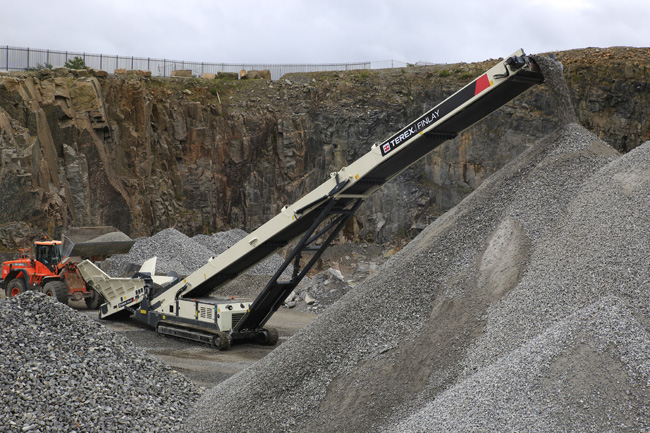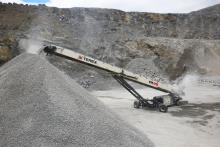
The global conveyors market is going from strength to strength, with a host of new models recently launched or set to be unveiled in the coming year. Guy Woodford reports.
Speaking at the recent
“Customers are experiencing the benefits of transferring and stockpiling materials using Terex conveyors. Our machines are built to be reliable and efficient and offer operators real savings across their operations. Costs in terms of fuel and manpower are reduced as is the dependency upon wheeled loaders or haul trucks to transfer material from the quarry face. The operator will also benefit from reduced downtime and an increased lifespan of their equipment. There are also safety advantages, as you have less machine movement around your job site.”
Bratton said there is further growth potential for Terex MP conveyors in both the quarry and port terminal sectors. “We have established a full-time dedicated design team based at our site in Omagh (Northern Ireland), and utilise the Terex Innovation and Research Centre, where we carry out full FEA (finite element analysis) of our structures. All products are then put through our rigorous in-house testing and field trial process to guarantee the quality of our product and to ensure our designs are second to none. We have an ambitious new product development strategy and you will see a steady stream of new products coming onto the market in the near future.
“We now have a very strong value proposition for customers; a comprehensive product range backed up by the world-class aftermarket support delivered by each and every Terex MP dealer.”
Bratton said the 22.9m TF-75L low-level and TF-75H high-level tracked mobile conveyors are progressing well through the testing stages and are due to go into production in September 2018. These models will be followed by the 30m TC-100 in November 2018, and the TR-75 tracked radial conveyors will start coming off the production line in Q1 2019.
ProSpare was at Hillhead 2018 showcasing the innovative Starclean conveyor belt cleaning system, along with the firm’s wide range of conveyor components.
Based in Pinxton, Derbyshire, England, ProSpare is the sole distributor for Starclean made by F.E. Schulte Strathaus, one of Europe’s largest and most respected belt cleaner manufacturers. The Starclean range incorporates a novel twist-swing tensioning mechanism, ensuring blade contact to the belt regardless of individual segment wear, excellent cleaning performance and a minimal maintenance, cost-effective operation.
Starclean’s innovative, site-proven design is different to traditional scrapers and is said by ProSpare to offer far better reliability. A key design feature is within the ingenious tensioning devices. The simplicity of the quick-release mechanism and quick-change, slot-in blade design means in-house site staff can quickly and safely carry out tool-less maintenance. ProSpare claims it literally takes seconds to disengage, maintain and re-tension, keeping maintenance costs and downtime to a minimum.
Among ProSpare’s conveyor components at Hillhead 2018 were Friflo impact bars that support conveyor belts at loading points, helping prevent belt damage and minimise belt wear. The company also offers, among other components, SPILL-EX skirt sealing systems, which prevent spillage and dust at conveyor loading and transfer points, and Centrax conveyor belt trackers, which quickly and automatically correct belt misalignment.
Northern Ireland-based Smiley Monroe, a global market manufacturer of endless conveyor belts and custom cut parts (CCP) for original equipment manufacturers (OEMs) within the crushing, screening, recycling, road construction and environmental industries, says it expects to achieve 20% growth in 2018, compared to last year.
In addition to the firm’s HQ and primary manufacturing site in Ferguson Drive, Lisburn, near Belfast,
Sales of endless conveyor belts and Zip Clip,
Forty more employees have been hired in 2018 by Smiley Monroe to carry out a variety of roles within the company. The firm has been working on tackling ‘pain points’ that customers may encounter when buying products over the phone or by email. This includes the creation of a completely redesigned technical zone and tool kit on the company’s website, which now features video ‘how-to guides’ for technicians and more in-depth product information for engineers working with Smiley Monroe products. The videos were showcased on the company’s stand at Hillhead 2018.
Smiley Monroe has also unveiled a set of five core values that it believes are key to the company’s ongoing success: being a safe place to work; problem solvers; one big family; close to our customers; and determined to succeed. Each of the core values will be highlighted in new company promotional videos.
Smiley Monroe turns 40-years-old in 2019 and its presence at the globally-renowned
Martin Engineering, a leading American global conveyor technology manufacturer, has helped mitigate dust emissions at the underground limestone mine of Continental Cement Company’s Hannibal, Montana-based cement plant by implementing an innovative transfer point solution.
Using a specially-designed dust control unit (DCU) to spray a surfactant onto both sides of the cargo stream during transfer onto the main conveyor,
Continental Cement has been in operation since 1903. Over more than a century, the company has continued to improve and increase operations to reach a current cement production capacity of 1.1million tonnes/year of clinker.
A 106 metre underground mine now provides the primary source of limestone, which makes up 75% of the raw material required to produce the meal in the company’s Type I/II, and Type III Portland cement. Yielding 1.4 million tonnes of limestone annually, the extracted material is transported via truck and high-speed conveyors in order to move it to the surface, where it is held in a 100,000 ton (≈91,000 tonne) outdoor storage pile, then processed through a four-stage preheater/precalciner dry process cement kiln.
Fifty-tonne trucks dump 544-589tonnes/hour of extracted limestone into an underground hopper that feeds an impact crusher, which reduces the rocks to -10.1cm. The aggregate is then loaded onto Conveyor 0, a 152.4cm wide belt traveling approximately 3.5m/second) for 122m. The rock is discharged through a transfer chute onto Conveyor 1, travelling up the 400m inclined belt to the surface and dropping 6m onto the outdoor storage pile.
The two main areas we identified as having unacceptable dust emissions were at the underground crusher hopper and outdoors where the material was discharged onto the stockpile,” explains environmental manager Leonard Rosenkrans.
The original dust control equipment followed a traditional approach, with a goal of wetting the surface of the cargo. However, operators learned that limestone dust was not being adequately controlled by the water alone. Martin Engineering representatives visited the site with a trailer containing a fully-functional Martin Dust Control Unit (DCU), allowing a full demonstration of the unit’s capabilities. Conducting an end-to-end walkthrough of the cargo flow, technicians were able to determine the best course of action.
“After inspection, we devised a plan that optimized the dust control at both locations, while using as much common equipment as possible,” said Brian Nance, product engineer at Martin Engineering.
A six-nozzle, cradle-mount system was installed to provide serviceability at the Conveyor 1 discharge, and a manifold system was placed to address the issues at the dump pocket. Material monitoring sensors were employed at both locations to ensure application only when needed.
The pumps in the DCU are powered by variable frequency drive (VFD), allowing independent control over the flow of water and chemicals for each pump. The proprietary Martin MEL-101 chemical binder additive is dosed at the proper ratio to suit the operating conditions. The entire system is integrated with the plant’s control system, so that it can be monitored remotely.
With an approximate 300:1 water-to-additive ratio, the MEL-101 supports the water’s role in providing dust suppression using economically concentrated volumes. To control costs, the VFD-driven pump regulates chemical flow by releasing chemicals only when material is detected on the conveyors.
Nozzles were placed at the hopper mouth so the DCU could spray treated moisture inward toward the impact zone. By keeping the particles within the material flow, the new dust control system helps minimize health and safety issues, reduce wear and tear on equipment and create a better work environment.
After some fine-tuning to obtain the optimal chemical-to-water ratio, as well as proper sprayer placement for best coverage of the cargo flow, the system has eliminated most visual signs of dust emissions and has drastically improved air quality in and out of the mine.
“It’s almost like a light switch,” Nance said. “Turn the DCU on and the dust is no longer present at either of the emission points. Turn it off and within a few minutes, the dust returns.”
There are 22 employees in the mine. The cost of cement industry dust to society and workers has been studied in depth by the Environmental Protection Agency (EPA) to justify dust regulations. The cost of the installation was about US$50,000 and the annual maintenance and chemical costs are about $35,000/year. The five-year Net Present Value (NPV) of the costs plus the investment is about $200,000. Using the data from the EPA report, the benefit to society created by Continental from being proactive in the mine is about $375,000. So, the intuitive decision to be proactive in protecting the workers and surrounding neighbourhoods was a wise choice. There are many ways to look at the direct benefit to the company, including reduced health and safety issues as well as increased equipment life.
“The Martin team has gone above and beyond to make sure everything is operational and efficient,” Rosenkrans concluded. “We are currently considering a service contract for the new dust system, and potentially including the company’s onsite belt cleaner blade replacement service as well. From our first encounter, we’ve had a positive experience throughout the entire process and we’re very satisfied with the result.”









